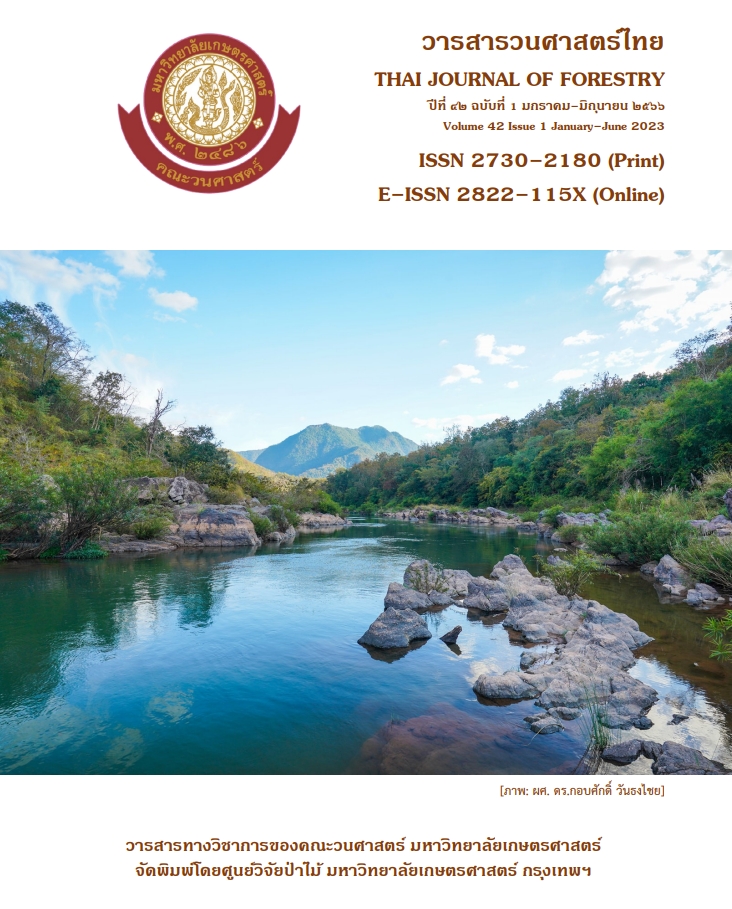การปรับเปลี่ยนรูปแบบการใช้ประโยชน์ที่ดินของเกษตรกรบ้านห้วยโป่ง ตำบลแม่ตื่น อำเภอแม่ระมาด จังหวัดตาก
Main Article Content
บทคัดย่อ
การศึกษาครั้งนี้มีวัตถุประสงค์เพื่อศึกษารูปแบบการใช้ที่ดิน แรงผลักดันทางด้านเศรษฐกิจ สังคม และสิ่งแวดล้อมที่ทำให้เกิดการปรับเปลี่ยนที่ดิน และความคิดเห็นของเกษตรกรต่อผลกระทบที่เกิดขึ้นหลังการปรับเปลี่ยนที่ดินโดยทำการศึกษาในบ้านห้วยโป่ง ตำบลแม่ตื่น อำเภอแม่ระมาด จังหวัดตาก เก็บรวบรวมข้อมูลด้วยแบบสัมภาษณ์ ทำการสัมภาษณ์ตัวแทนครัวเรือน จำนวน 86 ชุด วิเคราะห์ข้อมูลด้วยสถิติอย่างง่าย ใช้การวิเคราะห์แบบก้างปลาในการวิเคราะห์หาแรงผลักดันหลักในการปรับเปลี่ยนที่ดิน ผลการวิจัยพบว่า เกษตรกรเริ่มมีการปรับเปลี่ยนการใช้ที่ดินในปี พ.ศ. 2561 เป็นต้นมา โดยเห็นได้ชัดจากการลดลงของพื้นที่ข้าวไร่แบบไร่หมุนเวียนที่ลดลงจาก 648 ไร่ จาก 45 ครัวเรือน เป็น 358 ไร่ 33 ครัวเรือน ในปี 2564 โดยส่วนใหญ่ปรับเปลี่ยนไปเป็นพื้นที่ข้าวโพดเลี้ยงสัตว์ จาก 27 ไร่ ของ 2 ครัวเรือน เป็น 423 ไร่ จาก 29 ครัวเรือน แรงผลักดันสำคัญที่ทำให้เกิดการปรับเปลี่ยน ได้แก่ รายได้ของครัวเรือนที่เพิ่มขึ้น สำหรับความคิดเห็นต่อผลกระทบที่เกิดขึ้นหลังการปรับเปลี่ยนการใช้ที่ดิน พบว่า ผลกระทบด้านเศรษฐกิจส่วนใหญ่มองเป็นผลกระทบเชิงบวกเนื่องจากรายได้ครัวเรือนเพิ่มขึ้น ผลกระทบด้านสังคมมองเป็นเชิงบวกเรื่องความชัดเจนในการถือครองที่ดินและกรรมสิทธิ์ในที่ดิน ส่วนผลกระทบด้านสิ่งแวดล้อมมองเป็นเชิงลบเนื่องจากคุณภาพของดินในพื้นที่เกษตรกรรมมีความอุดมสมบูรณ์ของดินต่ำลง และพื้นที่ป่าไม้ลดลง
Downloads
Article Details

อนุญาตภายใต้เงื่อนไข Creative Commons Attribution-NonCommercial-NoDerivatives 4.0 International License.
ข้าพเจ้าและผู้เขียนร่วม (ถ้ามี) ขอรับรองว่า ต้นฉบับที่เสนอมานี้ยังไม่เคยได้รับการตีพิมพ์และไม่ได้อยู่ในระหว่างกระบวนการพิจารณาตีพิมพ์ลงในวารสารหรือสิ่งตีพิมพ์อื่นใด ข้าพเจ้าและผู้เขียนร่วม (ถ้ามี) ยอมรับหลักเกณฑ์และเงื่อนไขการพิจารณาต้นฉบับ ทั้งยินยอมให้กองบรรณาธิการมีสิทธิ์พิจารณาและตรวจแก้ต้นฉบับได้ตามที่เห็นสมควร พร้อมนี้ขอมอบลิขสิทธิ์ผลงานที่ได้รับการตีพิมพ์ให้แก่วารสารวนศาสตร์ คณะวนศาสตร์ มหาวิทยาลัยเกษตรศาสตร์ กรณีมีการฟ้องร้องเรื่องการละเมิดลิขสิทธิ์เกี่ยวกับภาพ กราฟ ข้อความส่วนใดส่วนหนึ่ง หรือ ข้อคิดเห็นที่ปรากฏในผลงาน ให้เป็นความรับผิดชอบของข้าพเจ้าและผู้เขียนร่วม (ถ้ามี) แต่เพียงฝ่ายเดียว และหากข้าพเจ้าและผู้เขียนร่วม (ถ้ามี) ประสงค์ถอนบทความในระหว่างกระบวนการพิจารณาของทางวารสาร ข้าพเจ้าและผู้เขียนร่วม (ถ้ามี) ยินดีรับผิดชอบค่าใช้จ่ายทั้งหมดที่เกิดขึ้นในกระบวนการพิจารณาบทความนั้น”
เอกสารอ้างอิง
Chotikijpiwat, J. 1999. Sustainable Land Management: A case Study of the Karen’s Shifting Cultivation in Chiangmai Province. M.A. Thesis, Chiangmai University. Chiangmai, Thailand. (in Thai)
Department of Lands. 2018. Provincial Land Use. http://www1.ldd.go.th/WEB_OLP/report_research_N.html, 15 March 2020. (in Thai)
Global Forest Watch (GFW). 2014. Thailand. https://www.globalforestwatch.org/dashboards/country/THA/ ,22 April 2020. (in Thai)
Kamyo, P., Yossuck, P., Panyadee, C., Fongmul, S. 2016. Meta-analysis of research on community forest management in Thailand. Governance Journal, 5(2): 238-255. (in Thai)
Krejcie, R.V., Morgan, D.W. 1970. Determining sample size for research activities. Educational and Psychological Measurement, 30(3): 607-610.
Mianmit, N., Pothitan, R. 2017. Fire management of rotational farming case study of Nam Moa village, Bokluea district, Nan province. In: Proceedings of the Forest Conference. September 5–7, 2017, Miracle Grand Convention Hotel, Bangkok, Thailand, pp. 242-248. (in Thai)
Mianmit, N., Pothitan, R., Jindawong, K. 2019. Management and Sustainable Use of Forest Resources of the Lerto Royal Project Development Center, Tak Province. Faculty of Forestry, Kasetsart University. Bangkok, Thailand. (in Thai)
Princess Maha Chakri Sirindhorn Anthropology Centre (SAC). 2017. The Rich Way: Shifting Cultivation with Karen. Blog. https://www.sac.or.th/databases/ethnicredb/blog_insidephp?id=1920, 20 October 2020. (in Thai)
Royal Forest Department. 2021. Operational Manual for the Reforestation Project. https://training.forest.go.th/mobile/ebook_pdf/8ae8e407864cd3b5e1298bdf1e6787f5.pdf, 6 September 2020. (in Thai)
Royal Project. 2012. Ler Tor Royal Project Development Center. Royal Project Development Center. http://royalproject thailand.com/Data7047, 12 July 2020. (in Thai)
Seub Nakhasathien Foundation. 2017. Report on the Situation of Thai Forests for the Year 2019–2020. https://www.seub.or.th/document/, 20 October 2020. (in Thai)


